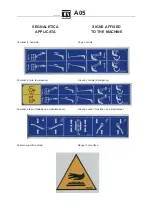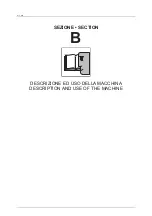
A04
1575_A04
PREPARAZIONE
ED ISPEZIONE
REQUISITI DI SERRAGGIO
La tabella delle coppie di serraggio (vedi pagine spe-
cifiche) consiste di valori di coppia standard, basati sul
diametro e la classe (durezza) della vite; essa stabilisce
anche i valori di coppia a secco e lubrificati secondo le
pratiche raccomandate dalla fabbrica.
Questa tabella è fornita per aiutare l’utente o l’opera-
tore nel caso venga constatata una condizione che ri-
chieda un’immediata attenzione durante l’ispezione o
durante il funzionamento, affinché sia informato il perso-
nale del servizio di manutenzione.
Utilizzando la tabella delle coppie di serraggio, in
abbinamento all’indice dei punti da serrare, riportato nel
capitolo “Manutenzione”, saranno migliorate la sicurez-
za e le prestazioni della macchina.
ISPEZIONE VISIVA GIORNALIERA
Rientra nelle responsabilità dell’operatore e dell’uten-
te di ispezionare la macchina ogni giorno lavorativo, pri-
ma dell’avviamento.
Si raccomanda ad ogni operatore e ad ogni utente di
eseguire l’ispezione della macchina prima del funziona-
mento, anche se la macchina è stata già messa in servi-
zio da un altro utente/operatore.
Questa ispezione visiva giornaliera è il sistema mi-
gliore di ispezione.
Questi controlli devono essere eseguiti anche dopo
la manutenzione della macchina.
Oltre all’ispezione visiva giornaliera, assicurarsi di
includere le seguenti operazione come parte dell’ispe-
zione giornaliera:
1 - Pulizia generale
Controllare che tutte le superfici di supporto siano
libere da versamenti di olio, carburante, olio idrauli-
co, fango e da oggetti estranei. Assicurare lo stato di
pulizia generale.
2 - Targhette
Mantenere tutte le targhette di informazione e di fun-
zionamento pulite e visibili. Per mantenere la visibi-
lità, si consiglia di proteggerle quando si spruzza
della vernice o si esegue la sabbiatura.
3 - Manuale di uso e manutenzione
Assicurarsi che una copia di questo manuale sia
conservata nell’apposito contenitore.
4 - Giornale della macchina
Assicurarsi di tenere l’annotazione o ancora meglio un
giornale di funzionamento della macchina; assicurarsi
che sia aggiornato e che nessun elemento sia lasciato in
dubbio, ciò potrebbe ridurre la sicurezza della macchina.
PREPARATION
AND INSPECTION
BOLT AND SCREW TIGHTENING
The tightening torque table (see the pages specified)
consists of standard torque values, based on the diam-
eter and the class (hardness) of the screws; this also es-
tablishes the torque values with and without lubricants
according to the practice recommended by the factory.
This table is provided for the purpose of helping
the user or the operator if the need should arise for
immediate adjustment during an inspection or opera-
tion so that the maintenance service personnel are
informed.
Using the tightening torque table in combination with
the index of the points to be tightened shown in the chap-
ter entitled “Maintenance” will improve the safety and
performance of the machine.
DAILY VISUAL INSPECTION
Inspection on workdays before starting up the ma-
chine comes under the responsibility of the operator and
the user.
Operators and users are advised to inspect the ma-
chine before use, even if the machine has already been
used by another user/operator.
This daily visual inspection is the best inspection sys-
tem.
These checks must also be made after maintenance
has been done to the machine.
In addition to the daily visual inspection, make sure
that the following operations are included as a part of the
daily inspection procedure:
1 - General cleaning
Check that all the weight-bearing surfaces are free
of spills of oil, fuel, hydraulic oil, mud and foreign
bodies. Check the general cleanliness.
2 - Plates
Keep all the plates showing information and control
labels clean and visible. To keep them visible it is
advisable to cover them when spraying paint or sand
blasting.
3 - Owner’s manual
Ensure that a copy of this manual is kept in the spe-
cial container.
4 - Machine logbook
Ensure that notes are kept, or even better a logbook
for the machine; ensure that it is kept up to date and
that nothing is left in doubt, as this could reduce the
safety of the machine.
















































